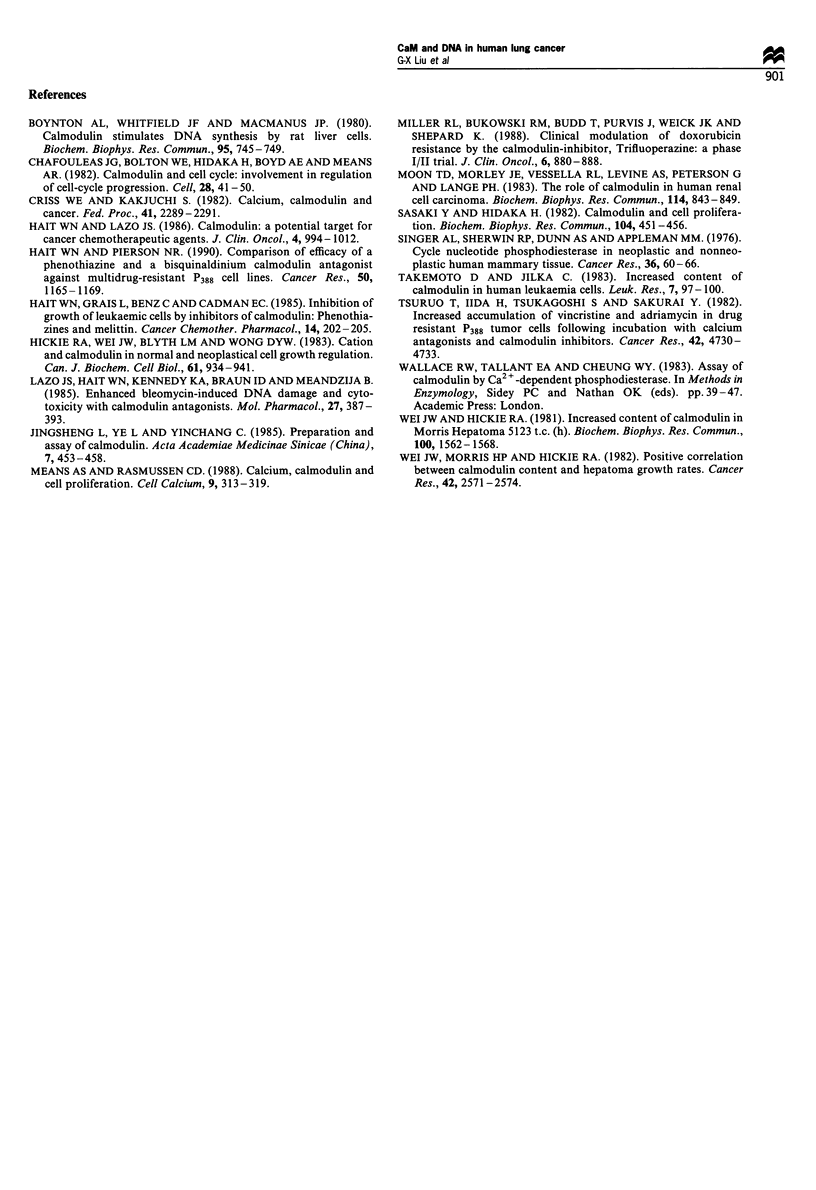Abstract
In order to study the role of calmodulin (CaM) in the proliferation of lung cancer cells, the CaM level of the specimens of 40 cases of primary lung cancers and the DNA content of the specimens of 35 cases of primary lung cancers were determined with phosphodiesterase assay and flow cytometry respectively. It was found that the CaM level of lung cancers was significantly higher than that of host lungs, benign lung diseases and normal lungs (p<0.001) and that it was significantly correlated with the histopathological grading and TNM staging of the lung cancers. It was also found that the cellular DNA content of lung cancers, like the CaM level, was also significantly higher than that of benign lung diseases and normal lungs (p<0.001). There was a significant positive correlation between the cellular DNA content and tissue CaM level in lung cancers (r=0.885). It is believed that CaM plays an important role in the proliferation of lung cancer cells through the mechanism of the promotion of an uncontrolled synthesis of DNA in the cells. Consequently, it is inferred that CaM antagonists may be tried as a chemotherapeutic agent for lung cancer.
Full text
PDF


Selected References
These references are in PubMed. This may not be the complete list of references from this article.
- Boynton A. L., Whitfield J. F., MacManus J. P. Calmodulin stimulates DNA synthesis by rat liver cells. Biochem Biophys Res Commun. 1980 Jul 31;95(2):745–749. doi: 10.1016/0006-291x(80)90849-9. [DOI] [PubMed] [Google Scholar]
- Chafouleas J. G., Bolton W. E., Hidaka H., Boyd A. E., 3rd, Means A. R. Calmodulin and the cell cycle: involvement in regulation of cell-cycle progression. Cell. 1982 Jan;28(1):41–50. doi: 10.1016/0092-8674(82)90373-7. [DOI] [PubMed] [Google Scholar]
- Criss W. E., Kakiuchi S. Calcium: calmodulin and cancer. Fed Proc. 1982 May;41(7):2289–2291. [PubMed] [Google Scholar]
- Hait W. N., Grais L., Benz C., Cadman E. C. Inhibition of growth of leukemic cells by inhibitors of calmodulin: phenothiazines and melittin. Cancer Chemother Pharmacol. 1985;14(3):202–205. doi: 10.1007/BF00258116. [DOI] [PubMed] [Google Scholar]
- Hait W. N., Lazo J. S. Calmodulin: a potential target for cancer chemotherapeutic agents. J Clin Oncol. 1986 Jun;4(6):994–1012. doi: 10.1200/JCO.1986.4.6.994. [DOI] [PubMed] [Google Scholar]
- Hait W. N., Pierson N. R. Comparison of the efficacy of a phenothiazine and a bisquinaldinium calmodulin antagonist against multidrug-resistant P388 cell lines. Cancer Res. 1990 Feb 15;50(4):1165–1169. [PubMed] [Google Scholar]
- Hickie R. A., Wei J. W., Blyth L. M., Wong D. Y., Klaassen D. J. Cations and calmodulin in normal and neoplastic cell growth regulation. Can J Biochem Cell Biol. 1983 Aug;61(8):934–941. doi: 10.1139/o83-119. [DOI] [PubMed] [Google Scholar]
- Lazo J. S., Hait W. N., Kennedy K. A., Braun I. D., Meandzija B. Enhanced bleomycin-induced DNA damage and cytotoxicity with calmodulin antagonists. Mol Pharmacol. 1985 Mar;27(3):387–393. [PubMed] [Google Scholar]
- Means A. R., Rasmussen C. D. Calcium, calmodulin and cell proliferation. Cell Calcium. 1988 Dec;9(5-6):313–319. doi: 10.1016/0143-4160(88)90012-7. [DOI] [PubMed] [Google Scholar]
- Miller R. L., Bukowski R. M., Budd G. T., Purvis J., Weick J. K., Shepard K., Midha K. K., Ganapathi R. Clinical modulation of doxorubicin resistance by the calmodulin-inhibitor, trifluoperazine: a phase I/II trial. J Clin Oncol. 1988 May;6(5):880–888. doi: 10.1200/JCO.1988.6.5.880. [DOI] [PubMed] [Google Scholar]
- Moon T. D., Morley J. E., Vessella R. L., Levine A. S., Peterson G., Lange P. H. The role of calmodulin in human renal cell carcinoma. Biochem Biophys Res Commun. 1983 Jul 29;114(2):843–849. doi: 10.1016/0006-291x(83)90858-6. [DOI] [PubMed] [Google Scholar]
- Sasaki Y., Hidaka H. Calmodulin and cell proliferation. Biochem Biophys Res Commun. 1982 Jan 29;104(2):451–456. doi: 10.1016/0006-291x(82)90658-1. [DOI] [PubMed] [Google Scholar]
- Singer A. L., Sherwin R. P., Dunn A. S., Appleman M. M. Cyclic nucleotide phosphodiesterases in neoplastic and nonneoplastic human mammary tissues. Cancer Res. 1976 Jan;36(1):60–66. [PubMed] [Google Scholar]
- Takemoto D., Jilka C. Increased content of calmodulin in human leukemia cells. Leuk Res. 1983;7(1):97–100. doi: 10.1016/0145-2126(83)90062-0. [DOI] [PubMed] [Google Scholar]
- Tsuruo T., Iida H., Tsukagoshi S., Sakurai Y. Increased accumulation of vincristine and adriamycin in drug-resistant P388 tumor cells following incubation with calcium antagonists and calmodulin inhibitors. Cancer Res. 1982 Nov;42(11):4730–4733. [PubMed] [Google Scholar]
- Wallace R. W., Tallant E. A., Cheung W. Y. Assay of calmodulin by Ca2+-dependent phosphodiesterase. Methods Enzymol. 1983;102:39–47. doi: 10.1016/s0076-6879(83)02006-6. [DOI] [PubMed] [Google Scholar]
- Wei J. W., Hickie R. A. Increased content of calmodulin in Morris hepatoma 5123 t.c. (h). Biochem Biophys Res Commun. 1981 Jun;100(4):1562–1568. doi: 10.1016/0006-291x(81)90697-5. [DOI] [PubMed] [Google Scholar]
- Wei J. W., Morris H. P., Hickie R. A. Positive correlation between calmodulin content and hepatoma growth rates. Cancer Res. 1982 Jul;42(7):2571–2574. [PubMed] [Google Scholar]


